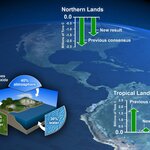Environment

A team of scientists from WWF and Conservation International (CI) has discovered the world’s largest known population of grey-shanked doucs (Pygathrix cinerea), increasing chances that the endangered monkey can be saved from extinction.
The grey-shanked douc is one of the world’s 25 most endangered primates and has only been recorded in the five central Vietnamese provinces of Quang Nam, Kon Tum, Quang Ngai, Binh Dinh, and Gia Lai. Fewer than 1,000 individuals are believed to still exist, and until now, only one other population with more than 100 animals was known.
“This is an exciting and…
You can’t watch the news, turn on the radio, or open a newspaper these days without hearing about global warming. It seems our future is looking rather warmish, and many of our modern conveniences may be to blame.
I’m not disputing the fact, but at the same time I’ve never had it explained to me precisely and quantitatively how many of the choices I make each day are contributing to global warming. I mean, I understand the link between driving my car and carbon emissions. The family minivan spews carbon dioxide for goodness sake, so I clearly understand how running my daily errands in a…

Researchers at the University of Utah and elsewhere have developed a new way to predict when vegetation dries to the point it is most vulnerable to large-scale fires in the Santa Monica Mountains near Los Angeles. And this year’s forecast says the highest-risk fire period will begin July 13 – weeks earlier than usual.
Despite that, the new study also shows that unlike other areas of the western United States, global warming has not caused any apparent long-term trend toward early fire seasons in the Santa Monicas.
The scientists eventually hope to expand their unique fire-risk forecasting…

Deep coal seams that are not commercially viable for coal production could be used for permanent underground storage of carbon dioxide (CO2) generated by human activities, thus avoiding atmospheric release, according to two studies published in Inderscience's International Journal of Environment and Pollution. An added benefit of storing CO2 in this way is that additional useful methane will be displaced from the coal beds.
Finding ways to store (sequester) the greenhouse gas CO2, indefinitely, is one approach being investigated in efforts to reduce atmospheric CO2 levels and so help combat…

Forests in the United States and other northern mid- and upper-latitude regions are playing a smaller role in offsetting global warming than previously thought, according to a new study.
The study, which sheds light on the so-called missing carbon sink, concludes that intact tropical forests are removing an unexpectedly high proportion of carbon dioxide from the atmosphere, thereby partially offsetting carbon entering the air through industrial emissions and deforestation.
"This research fills in another piece of the complex puzzle on how the Earth system functions," said Cliff Jacobs of NSF'…

David H. Ingbar MD, president of the American Thoracic Society, today called the proposed standards issued by the Environmental Protection Agency for ozone pollution–commonly known as smog-“unhealthy for America’s kids, unhealthy for America’s seniors, and unhealthy for America.”
“The science is clear,” Dr. Ingbar said, “ozone pollution is causing unnecessary, illnesses and death in America. The proposed EPA standards fall short of providing the protection needed to keep Americans safe from ozone air pollution.”
In announcing the proposed standard today, EPA is calling for a modest…
A method for increasing plants’ tolerance to salt stress and thus preventing stunted growth and even plant death has been developed. The method has significant consequences for dealing with soil salinization, which is an acute problem for a wide range of crops in many regions of the world.
Magnified photo at left shows the invasion of heavy oxidation (green bubbles) in the membrane of a wild, stressed, salt-sensitive plant. At right, following genetic manipulation, the bubbles are broken up and "caged" into tiny vesicles, thus preventing interference with the flow of vital nutrients in the…

Human-caused nitrogen deposition has been indirectly “fertilizing” forests, increasing their growth and sequestering major amounts of carbon, a new study suggests.
The findings create a more complex view of the carbon cycle in forests, where it was already known that logging or other stand-replacement events – whether natural or not – create periods of 5-20 years when there is a net release of carbon dioxide from forests to the atmosphere, instead of sequestration as they do later on.
The end result is a highly variable forest carbon cycle that appears to be heavily influenced by the…
Seen thundering across the landscape during an aerial survey, more than 1.3 million white-eared kob, tiang (African antelope), and mongalla gazelle are thriving in Southern Sudan, despite all odds. An estimated 8,000 elephants, concentrated mainly in the Sudd, the largest freshwater wetland in Africa, have also been observed.
Despite the war, some species of wildlife in Southern Sudan, last surveyed more than 25 years ago, have not only survived but have thrived east of the Nile River in numbers that rival those of the Serengeti.
Photo by P.Elkan ©2007 WCS/National Geographic Oryx, Boma…

Yesterday, the Israeli Air Force took out at least two buildings in Gaza City in response to the previous day’s Palestinian militants’ attack. Not far away, a group of environmentalists called Friends of the Earth Middle East is taking a different tack to quell the violence. By bringing together Israelis, Palestinians and Jordanians to work together on environmental issues that affect them all, they hope to build lasting peace.
It seems to be working.
Take the West Bank village of Baqa Al-Sharqiya, for example. Only four years ago the Israeli Army surrounded it with a Security Barrier…